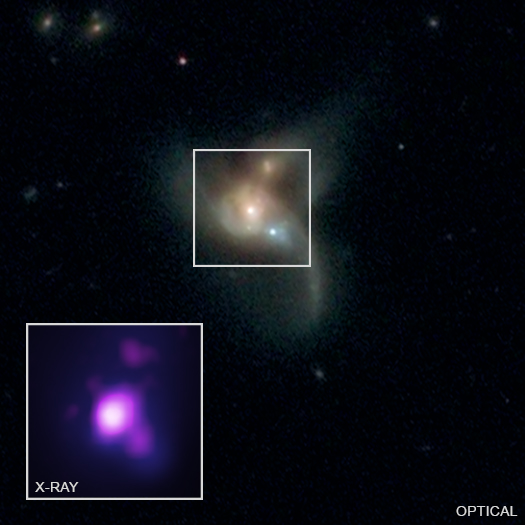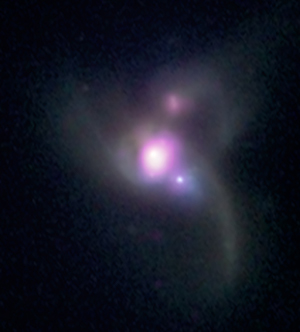Found: Three Black Holes On Collision Course

SDSS J084905.51+111447.2
Credit: X-ray: NASA/CXC/George Mason Univ./R. Pfeifle et al.; Optical: SDSS & NASA/STScI
A new study using data from NASA's Chandra X-ray Observatory and other telescopes provides the strongest evidence yet for a system of three supermassive black holes, as described in our latest press release. Astronomers think these triplet collisions, while extremely rare, play a critical role in how the biggest black holes grow over time.
The system is known as SDSS J084905.51+111447.2 (SDSS J0849+1114 for short) and is located a billion light years from Earth. In this graphic, X-rays from Chandra (purple) are shown in the pull-out in comparison with optical light from the Hubble Space Telescope and the Sloan Digital Sky Survey (red, green, and blue) in the main panel.
The Chandra data revealed three X-ray sources — a tell-tale sign of material being consumed by the black holes — at the bright centers of each galaxy in the merger, exactly where scientists expect supermassive black holes to reside. The separations between the black holes range between about 10,000 and 30,000 light years. Chandra and NASA's NuSTAR also found evidence for large amounts of gas and dust around one of the black holes, typical for a merging black hole system.
SDSS J0849+1114 was first flagged as a potential system of colliding black holes by SDSS with the help of citizen scientists across the globe as part of the Galaxy Zoo Project.
Then infrared imaging data from NASA's WISE mission revealed that the system was glowing intensely in the infrared during a phase in the galaxy merger when more than one of the black holes is expected to be feeding rapidly. To follow up on these clues, astronomers then turned to Chandra and the Large Binocular Telescope (LBT) in Arizona.
One reason it is difficult to find a triplet of supermassive black holes is that they are likely to be shrouded in gas and dust, blocking much of their light. The infrared images of WISE, the infrared spectra from LBT and the X-ray images from Chandra bypass this issue, because infrared and X-ray light pierce clouds of gas much more easily than optical light.
The paper, led by Ryan Pfeifle of George Mason University in Fairfax, Virginia, describing these results appears in the latest issue of The Astrophysical Journal and a preprint is also available. NASA's Marshall Space Flight Center manages the Chandra program. The Smithsonian Astrophysical Observatory's Chandra X-ray Center controls science and flight operations from Cambridge, Massachusetts.
Category:
- Log in to post comments

